「第十三章」 非结构化数据提取(三)
13.6 BeautifulSoup4 解析器
和 lxml 一样,Beautiful Soup 也是一个HTML/XML的解析器,主要的功能也是如何解析和提取 HTML/XML 数据。
lxml 只会局部遍历,而Beautiful Soup是基于HTML DOM的,会载入整个文档,解析整个DOM树,因此时间和内存开销都会大很多,所以性能要低于lxml。
BeautifulSoup 用来解析 HTML 比较简单,API非常人性化,支持CSS选择器、Python标准库中的HTML解析器,也支持 lxml 的 XML解析器。
官方文档:http://beautifulsoup.readthedocs.io/zh_CN/v4.4.0
13.6.1 BeautifulSoup4的安装
用 pip 安装即可:pip install beautifulsoup4

13.6.2 BeautifulSoup4的第一个示例
例子:
from bs4 import BeautifulSoup
html = """
The Dormouse's storyThe Dormouse's story
Once upon a time there were three little sisters; and their names were
,
Lacie and
Tillie;
and they lived at the bottom of a well.
...
"""
#创建 Beautiful Soup 对象
soup = BeautifulSoup(html)
#格式化输出 soup 对象的内容
print(soup.prettify())
运行结果:
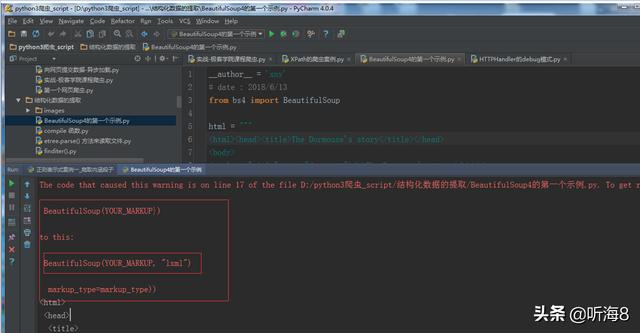
在 Python3 下执行,会看到这样一段警告:
BeautifulSoup(YOUR_MARKUP})
to this:
BeautifulSoup(YOUR_MARKUP, "lxml")
markup_type=markup_type))
意思是,如果我们没有显式地指定解析器,所以默认使用这个系统的最佳可用HTML解析器("lxml")。如果你在另一个系统中运行这段代码,或者在不同的虚拟环境中,使用不同的解析器造成行为不同。
我们可以通过soup = BeautifulSoup(html, "lxml")方式指定lxml解析器。

13.6.3 文件读取
在当前文件夹创建一个BeautifulSoup.html文件。
文件内容如下:
The Dormouse's storyThe Dormouse's story
Once upon a time there were three little sisters; and their names were
,
Lacie and
Tillie;
and they lived at the bottom of a well.
...
例子:
from bs4 import BeautifulSoup
#打开本地 HTML 文件的方式来创建对象
soup = BeautifulSoup(open('./BeautifulSoup.html'),"lxml")
#格式化输出 soup 对象的内容
print(soup.prettify())
运行结果:

13.6.4 各数据抓取工具的对比
学习了3种数据的抓取工具和方法,如下比较下这3种方法的优缺点。

13.6.5 BeautifulSoup四大对象种类
Beautiful Soup将复杂HTML文档转换成一个复杂的树形结构,每个节点都是Python对象,所有对象可以归纳为4种:
1.Tag
2.NavigableString
3.BeautifulSoup
4.Comment
(一)Tag
Tag 通俗点讲就是 HTML 中的一个个标签,例如:
The Dormouse's storyThe Dormouse's story
上面的 title head a p等等 HTML 标签加上里面包括的内容就是 Tag,那么试着使用 Beautiful Soup 来获取 Tags。
例子:
from bs4 import BeautifulSoup
html = """
The Dormouse's storyThe Dormouse's story
Once upon a time there were three little sisters; and their names were
,
Lacie and
Tillie;
and they lived at the bottom of a well.
...
"""
#创建 Beautiful Soup 对象
soup = BeautifulSoup(html,"lxml")
print(soup.title)
#
The Dormouse's storyprint(soup.head)
#
The Dormouse's storyprint(soup.a)
#
print(soup.p)
#
The Dormouse's story
print(type(soup.p))
#
运行结果:
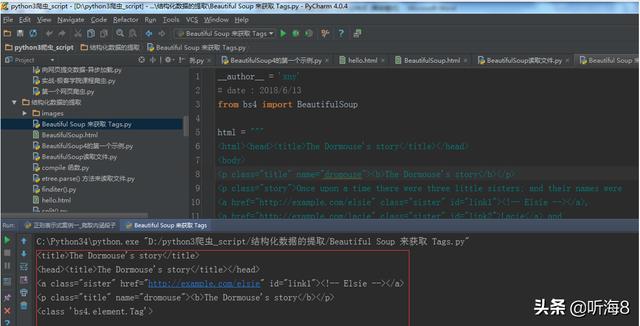
我们可以利用 soup 加标签名轻松地获取这些标签的内容,这些对象的类型是bs4.element.Tag。但是注意,它查找的是在所有内容中的第一个符合要求的标签。如果要查询所有的标签,后面会进行介绍。
对于 Tag,它有两个重要的属性,是 name 和 attrs
例子:
from bs4 import BeautifulSoup
html = """
The Dormouse's storyThe Dormouse's story
Once upon a time there were three little sisters; and their names were
,
Lacie and
Tillie;
and they lived at the bottom of a well.
...
"""
#创建 Beautiful Soup 对象
soup = BeautifulSoup(html,"lxml")
print(soup.name)
# [document] #soup 对象本身比较特殊,它的 name 即为 [document]
print(soup.head.name)
# head #对于其他内部标签,输出的值便为标签本身的名称
print(soup.p.attrs)
# {'class': ['title'], 'name': 'dromouse'}
# 在这里,我们把 p 标签的所有属性打印输出了出来,得到的类型是一个字典。
print(soup.p['class']) # soup.p.get('class')
# ['title'] #还可以利用get方法,传入属性的名称,二者是等价的
soup.p['class'] = "newClass"
print(soup.p) # 可以对这些属性和内容等等进行修改
#
The Dormouse's story
del soup.p['class'] # 还可以对这个属性进行删除
print(soup.p)
#
The Dormouse's story
运行结果:
[document]
head
{'class': ['title'], 'name': 'dromouse'}
['title']
The Dormouse's story
The Dormouse's story
(二)NavigableString
既然我们已经得到了标签的内容,那么问题来了,我们要想获取标签内部的文字怎么办呢?很简单,用 .string 即可。
例子:
from bs4 import BeautifulSoup
html = """
The Dormouse's storyThe Dormouse's story
Once upon a time there were three little sisters; and their names were
,
Lacie and
Tillie;
and they lived at the bottom of a well.
...
"""
#创建 Beautiful Soup 对象
soup = BeautifulSoup(html,"lxml")
print(soup.p.string)
# The Dormouse's story
print(type(soup.p.string))
# In [13]:
运行结果:
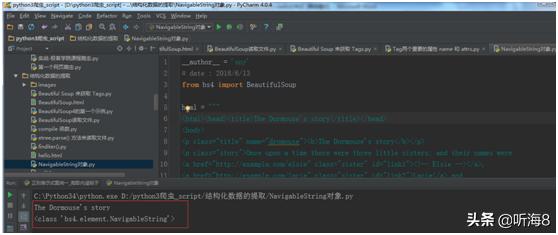
(三)BeautifulSoup
BeautifulSoup 对象表示的是一个文档的内容。大部分时候,可以把它当作 Tag 对象,是一个特殊的 Tag,我们可以分别获取它的类型,名称,以及属性来感受一下
例子:
from bs4 import BeautifulSoup
html = """
The Dormouse's storyThe Dormouse's story
Once upon a time there were three little sisters; and their names were
,
Lacie and
Tillie;
and they lived at the bottom of a well.
...
"""
#创建 Beautiful Soup 对象
soup = BeautifulSoup(html,"lxml")
print(type(soup.name))
#
print(soup.name)
# [document]
print(soup.attrs) # 文档本身的属性为空
# {}
运行结果:
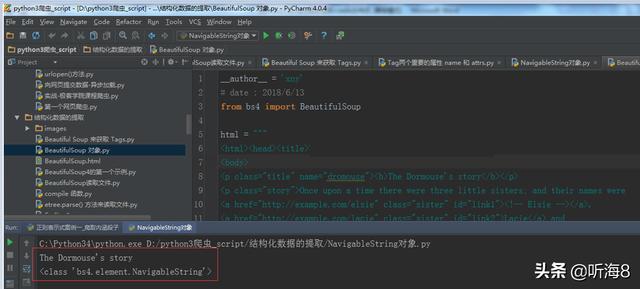
(四)Comment
Comment 对象是一个特殊类型的 NavigableString 对象,其输出的内容不包括注释符号。
例子:
from bs4 import BeautifulSoup
html = """
The Dormouse's storyThe Dormouse's story
Once upon a time there were three little sisters; and their names were
,
Lacie and
Tillie;
and they lived at the bottom of a well.
...
"""
#创建 Beautiful Soup 对象
soup = BeautifulSoup(html,"lxml")
print(soup.a)
#
print(soup.a.string)
# Elsie
print(type(soup.a.string))
#
运行结果:
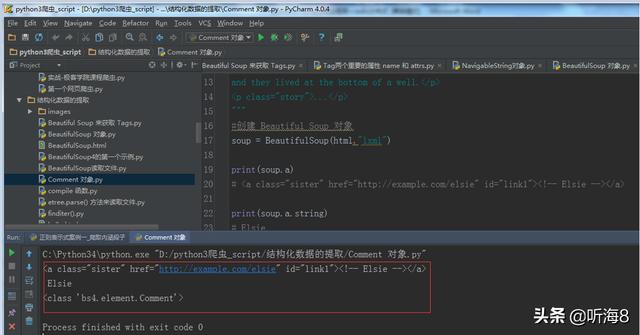
a 标签里的内容实际上是注释,但是如果我们利用 .string 来输出它的内容时,注释符号已经去掉了。
13.6.6 遍历文档树
1. 直接子节点 :.contents 和 .children 属性
.content 属性
tag 的 .content 属性可以将tag的子节点以列表的方式输出。
例子:
from bs4 import BeautifulSoup
html = """
The Dormouse's storyThe Dormouse's story
Once upon a time there were three little sisters; and their names were
,
Lacie and
Tillie;
and they lived at the bottom of a well.
...
"""
#创建 Beautiful Soup 对象
soup = BeautifulSoup(html,"lxml")
print(soup.head.contents)
#[
The Dormouse's story]运行结果:

[
The Dormouse's story]输出方式为列表,我们可以用列表索引来获取它的某一个元素
Print(soup.head.contents[0])
#
The Dormouse's story.children 属性
它返回的不是一个 list,不过我们可以通过遍历获取所有子节点。
我们打印输出 .children 看一下,可以发现它是一个 list 生成器对象。
例子:
from bs4 import BeautifulSoup
html = """
The Dormouse's storyThe Dormouse's story
Once upon a time there were three little sisters; and their names were
,
Lacie and
Tillie;
and they lived at the bottom of a well.
...
"""
#创建 Beautiful Soup 对象
soup = BeautifulSoup(html,"lxml")
print(soup.head.children)
#
for child in soup.body.children:
print(child)
运行结果:
The Dormouse's story
Once upon a time there were three little sisters; and their names were
,
Lacie and
Tillie;
and they lived at the bottom of a well.
...
2. 所有子孙节点: .descendants 属性
.contents 和 .children 属性仅包含tag的直接子节点,.descendants 属性可以对所有tag的子孙节点进行递归循环,和 children类似,我们也需要遍历获取其中的内容。
例子:
from bs4 import BeautifulSoup
html = """
The Dormouse's storyThe Dormouse's story
Once upon a time there were three little sisters; and their names were
,
Lacie and
Tillie;
and they lived at the bottom of a well.
...
"""
#创建 Beautiful Soup 对象
soup = BeautifulSoup(html,"lxml")
for child in soup.descendants:
print(child)
运行结果:
The Dormouse's story
The Dormouse's story
The Dormouse's story
Once upon a time there were three little sisters; and their names were
,
Lacie and
Tillie;
and they lived at the bottom of a well.
Once upon a time there were three little sisters; and their names were
Elsie
Lacie
Lacie
and
Tillie
Tillie
and they lived at the bottom of a well.
...
...
3. 节点内容: .string 属性
如果tag只有一个 NavigableString 类型子节点,那么这个tag可以使用 .string 得到子节点。如果一个tag仅有一个子节点,那么这个tag也可以使用 .string 方法,输出结果与当前唯一子节点的 .string 结果相同。
通俗点说就是:如果一个标签里面没有标签了,那么 .string 就会返回标签里面的内容。如果标签里面只有唯一的一个标签了,那么 .string 也会返回最里面的内容。
例子:
from bs4 import BeautifulSoup
html = """
The Dormouse's storyThe Dormouse's story
Once upon a time there were three little sisters; and their names were
,
Lacie and
Tillie;
and they lived at the bottom of a well.
...
"""
#创建 Beautiful Soup 对象
soup = BeautifulSoup(html,"lxml")
print(soup.head.string)
#The Dormouse's story
print(soup.title.string)
#The Dormouse's story
运行结果:
The Dormouse's story
The Dormouse's story
13.6.7 搜索文档树
1.find_all(name, attrs, recursive, text, **kwargs)
1)name 参数
name 参数可以查找所有名字为 name 的tag,字符串对象会被自动忽略掉
A.传字符串
最简单的过滤器是字符串.在搜索方法中传入一个字符串参数,Beautiful Soup会查找与字符串完整匹配的内容,下面的例子用于查找文档中所有的标签:
例子:
from bs4 import BeautifulSoup
html = """
The Dormouse's storyThe Dormouse's story
Once upon a time there were three little sisters; and their names were
,
Lacie and
Tillie;
and they lived at the bottom of a well.
...
"""
#创建 Beautiful Soup 对象
soup = BeautifulSoup(html,"lxml")
soup.find_all('b')
print(soup.find_all('a'))
运行结果:
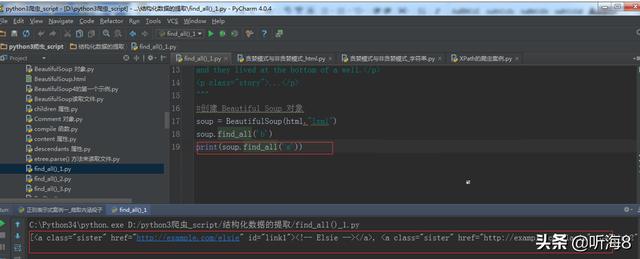
B.传正则表达式
如果传入正则表达式作为参数,Beautiful Soup会通过正则表达式的 match() 来匹配内容.下面例子中找出所有以b开头的标签,这表示
和 标签都应该被找到。例子:
from bs4 import BeautifulSoup
import re
html = """
The Dormouse's storyThe Dormouse's story
Once upon a time there were three little sisters; and their names were
,
Lacie and
Tillie;
and they lived at the bottom of a well.
...
"""
#创建 Beautiful Soup 对象
soup = BeautifulSoup(html,"lxml")
for tag in soup.find_all(re.compile("^b")):
print(tag.name)
运行结果:
body
b
C.传列表
如果传入列表参数,Beautiful Soup会将与列表中任一元素匹配的内容返回.下面代码找到文档中所有标签和标签。
例子:
from bs4 import BeautifulSoup
html = """
The Dormouse's storyThe Dormouse's story
Once upon a time there were three little sisters; and their names were
,
Lacie and
Tillie;
and they lived at the bottom of a well.
...
"""
#创建 Beautiful Soup 对象
soup = BeautifulSoup(html,"lxml")
print(soup.find_all(["a", "b"]))
for i in soup.find_all(["a", "b"]):
print(i)
运行结果:

2)keyword 参数
例子:
from bs4 import BeautifulSoup
html = """
The Dormouse's storyThe Dormouse's story
Once upon a time there were three little sisters; and their names were
,
Lacie and
Tillie;
and they lived at the bottom of a well.
...
"""
#创建 Beautiful Soup 对象
soup = BeautifulSoup(html,"lxml")
print(soup.find_all(id='link2'))
运行结果:
[Lacie]
3)text 参数
通过 text 参数可以搜搜文档中的字符串内容,与 name 参数的可选值一样, text 参数接受(字符串/正则表达式/列表)。
例子:
from bs4 import BeautifulSoup
import re
html = """
The Dormouse's storyThe Dormouse's story
Once upon a time there were three little sisters; and their names were
,
Lacie and
Tillie;
and they lived at the bottom of a well.
...
"""
#创建 Beautiful Soup 对象
soup = BeautifulSoup(html,"lxml")
print(soup.find_all(text="Elsie"))
# ['Elsie']
print(soup.find_all(text=["Tillie", "Elsie", "Lacie"]))
# ['Elsie', u'Lacie', u'Tillie']
print(soup.find_all(text=re.compile("Dormouse")))
["The Dormouse's story", u"The Dormouse's story"]
运行结果:
[]
['Lacie', 'Tillie']
["The Dormouse's story", "The Dormouse's story"]
13.7 css选择器
要使用css对HTML页面中的元素实现一对一,一对多或者多对一的控制,这就需要用到CSS选择器。
HTML页面中的元素就是通过CSS选择器进行控制的。
CSS选择器也是基于BeautifulSoup里的select()方法,与 find_all 方法使用类似,不过也是有以下2点区别。
1.写 CSS 时,标签名不加任何修饰,类名前加.,id名前加#
2.在这里我们也可以利用类似的方法来筛选元素,用到的方法是 soup.select(),返回类型是 list
13.7.1 CSS选择器分类
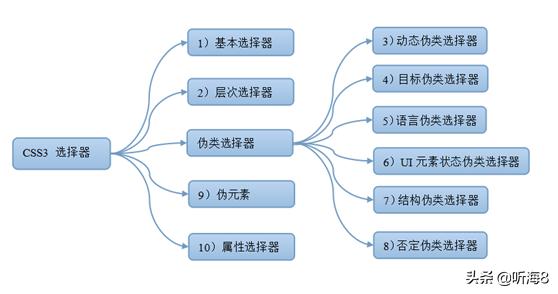
13.7.2 选择器语法
1、基本选择器语法。

2、层次选择器语法。
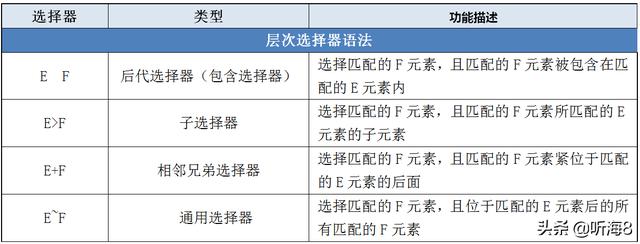
3、动态伪类选择器语法。
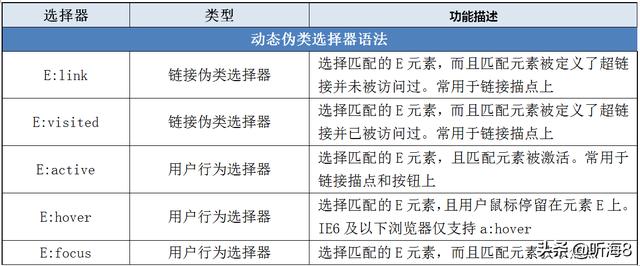
4、目标伪类选择器。

5、UI元素状态伪类选择器语法。

6、否定伪类选择器。

7、属性选择器语法。
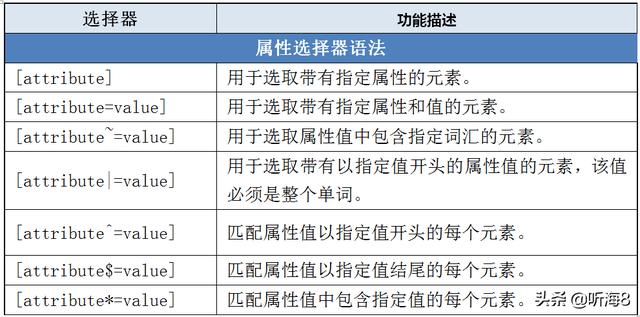
注:例
13.7.3 通过标签名查找
例子:
from bs4 import BeautifulSoup
html = """
The Dormouse's storyThe Dormouse's story
Once upon a time there were three little sisters; and their names were
,
Lacie and
Tillie;
and they lived at the bottom of a well.
...
"""
#创建 Beautiful Soup 对象
soup = BeautifulSoup(html,"lxml")
print(soup.select('title'))
print(soup.select('a'))
print(soup.select('b'))
运行结果:
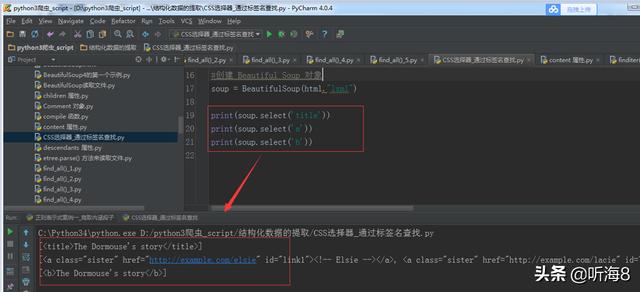
13.7.4 通过类名查找
例子:
from bs4 import BeautifulSoup
html = """
The Dormouse's storyThe Dormouse's story
Once upon a time there were three little sisters; and their names were
,
Lacie and
Tillie;
and they lived at the bottom of a well.
...
"""
#创建 Beautiful Soup 对象
soup = BeautifulSoup(html,"lxml")
print(soup.select('.sister'))
运行结果:
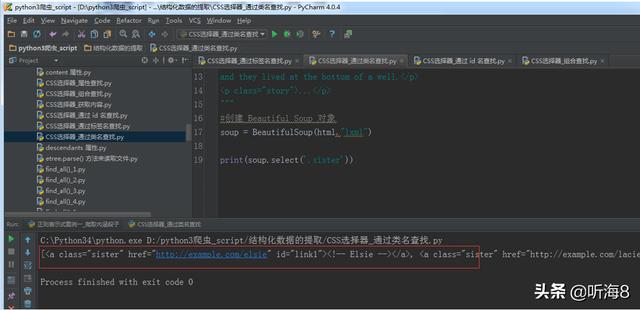
13.7.5 通过 id 名查找
例子:
from bs4 import BeautifulSoup
html = """
The Dormouse's storyThe Dormouse's story
Once upon a time there were three little sisters; and their names were
,
Lacie and
Tillie;
and they lived at the bottom of a well.
...
"""
#创建 Beautiful Soup 对象
soup = BeautifulSoup(html,"lxml")
print(soup.select('#link1'))
运行结果:

13.7.6 组合查找
组合查找即和写 class 文件时,标签名与类名、id名进行的组合原理是一样的,例如查找 p 标签中,id 等于 link1的内容,二者需要用空格分开。
例子:
from bs4 import BeautifulSoup
html = """
The Dormouse's storyThe Dormouse's story
Once upon a time there were three little sisters; and their names were
,
Lacie and
Tillie;
and they lived at the bottom of a well.
...
"""
#创建 Beautiful Soup 对象
soup = BeautifulSoup(html,"lxml")
print(soup.select('p #link1'))
运行结果:

直接子标签查找,则使用 > 分隔
例子:
from bs4 import BeautifulSoup
html = """
The Dormouse's storyThe Dormouse's story
Once upon a time there were three little sisters; and their names were
,
Lacie and
Tillie;
and they lived at the bottom of a well.
...
"""
#创建 Beautiful Soup 对象
soup = BeautifulSoup(html,"lxml")
print(soup.select("head > title"))
运行结果:
[
The Dormouse's story]13.7.7 属性查找
查找时还可以加入属性元素,属性需要用中括号括起来,注意属性和标签属于同一节点,所以中间不能加空格,否则会无法匹配到。
例子:
from bs4 import BeautifulSoup
html = """
The Dormouse's storyThe Dormouse's story
Once upon a time there were three little sisters; and their names were
,
Lacie and
Tillie;
and they lived at the bottom of a well.
...
"""
#创建 Beautiful Soup 对象
soup = BeautifulSoup(html,"lxml")
print(soup.select('a[class="sister"]'))
print(soup.select('a[href="http://example.com/elsie"]'))
运行结果:
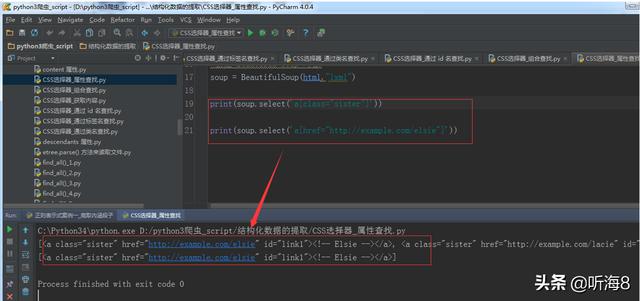
同样,属性仍然可以与上述查找方式组合,不在同一节点的空格隔开,同一节点的不加空格。
例子:
from bs4 import BeautifulSoup
html = """
The Dormouse's storyThe Dormouse's story
Once upon a time there were three little sisters; and their names were
,
Lacie and
Tillie;
and they lived at the bottom of a well.
...
"""
#创建 Beautiful Soup 对象
soup = BeautifulSoup(html,"lxml")
print(soup.select('p a[href="http://example.com/elsie"]'))
运行结果:
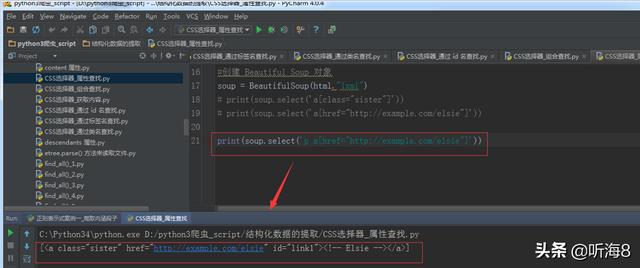
13.7.8 获取内容
以上的 select 方法返回的结果都是列表形式,可以遍历形式输出,然后用 get_text() 方法来获取它的内容。
例子:
from bs4 import BeautifulSoup
html = """
The Dormouse's storyThe Dormouse's story
Once upon a time there were three little sisters; and their names were
,
Lacie and
Tillie;
and they lived at the bottom of a well.
...
"""
#创建 Beautiful Soup 对象
soup = BeautifulSoup(html,"lxml")
print(type(soup.select('title')))
print(soup.select('title')[0].get_text())
for title in soup.select('title'):
print(title.get_text())
运行结果:
The Dormouse's story
The Dormouse's story
13.8 使用BeautifulSoup4 进行爬虫综合案例
腾讯社招页面:http://hr.tencent.com/position.php?&start=10#a

使用BeautifuSoup4解析器,将招聘网页上的职位名称、职位类别、招聘人数、工作地点、发布时间,以及每个职位详情的点击链接存储出来。

代码的实现:
from bs4 import BeautifulSoup
import json # 使用了json格式存储
from urllib import parse
import requests
from lxml import etree
def tencent():
url = 'http://hr.tencent.com/'
header = {"User-Agent": "Mozilla/5.0 (compatible; MSIE 9.0; Windows NT 6.1 Trident/5.0;"}
req = requests.get(url + 'position.php?&start=10#a',headers=header)
resHtml = req.text
output =open('./tencent.json','w+')
html = BeautifulSoup(resHtml,'lxml')
# 创建CSS选择器
result = html.select('tr[class="even"]')
result2 = html.select('tr[class="odd"]')
result += result2
items = []
for site in result:
item = {}
name = site.select('td a')[0].get_text()
detailLink = site.select('td a')[0].attrs['href']
catalog = site.select('td')[1].get_text()
recruitNumber = site.select('td')[2].get_text()
workLocation = site.select('td')[3].get_text()
publishTime = site.select('td')[4].get_text()
item['name'] = name
item['detailLink'] = url + detailLink
item['catalog'] = catalog
item['recruitNumber'] = recruitNumber
item['publishTime'] = publishTime
items.append(item)
# 禁用ascii编码,按utf-8编码
line = json.dumps(items,ensure_ascii=False)
output.write(line)
output.close()
if __name__ == "__main__":
tencent()
运行结果:
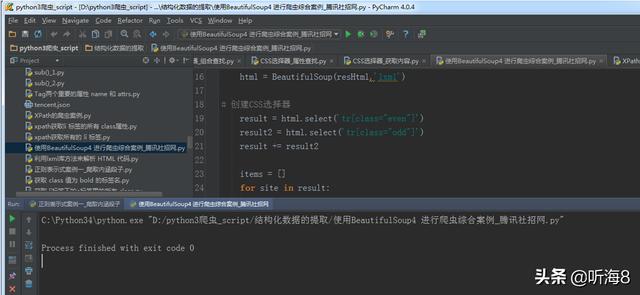
在当前文件夹目录多个tencent.json的文件。
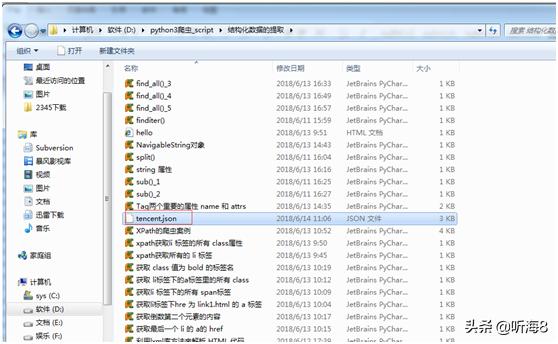
用EditPlus 3查看如下:

把返回的数据通过json线上解析工具对返回的JSON数据解析,我们可以直观的看出。
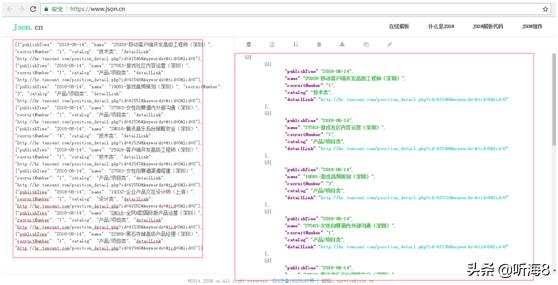




















 624
624











 被折叠的 条评论
为什么被折叠?
被折叠的 条评论
为什么被折叠?








